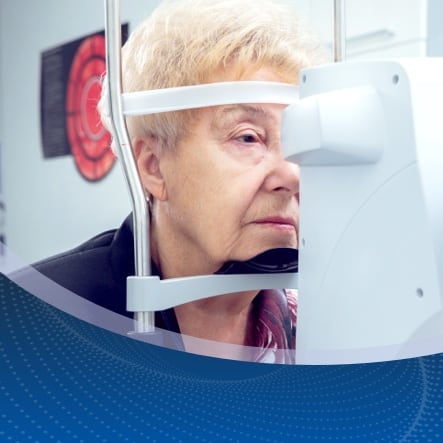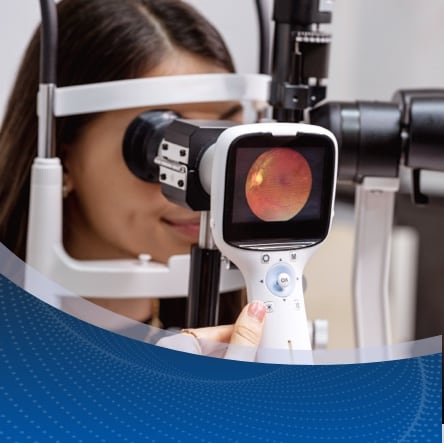Reviewed By: Paul M. Griffey M.D.
Cataracts typically develop over the course of several years, and this is part of the normal aging of the eye. According to the National Eye Institute, at around age 40, the proteins in the eye start to break down and stick together. This causes cloudiness of the eye’s natural lens. People with cataracts often describe their visual changes as blurry and hazy. Cataracts can make it challenging to read, see vivid colors, or drive a car, especially at night. Because most cataracts develop slowly, they don’t initially interfere with one’s eyesight but over time, cataracts will cause vision to become blurry.
If you’re experiencing blurry vision even after your cataract procedure, you may be wondering: Can cataract surgery be redone? While the short answer is no, there are effective alternatives depending on what’s causing your vision issues.
RISK FACTORS AND HOW TO SLOW PROGRESSION
There are risk factors to the speed at which cataracts develop. Aging and family history are risk factors you cannot control. However, to slow the progression of cataracts, we recommend:
- Quit smoking. Smoking causes the vessels in the retina to break down and become blocked, which will lead to cloudy vision.
- Maintain a healthy weight. Obesity leads to health issues such as diabetes and high blood pressure.
- Control high blood pressure. High blood pressure can damage and weaken the eye’s vessels.
- Control diabetes. High blood sugar levels can change the shape of the eye’s lens and cause cataracts to develop faster.
- Use UV protection when outdoors.
CATARACT SURGERY: THE STANDARD TREATMENT
Surgery is the only way to remove a cataract. Luckily, cataract surgery is a safe and effective procedure that can help you regain clear vision. The National Institute of Health conducted a survey in 2021 that determined cataract surgery to be the most common surgery in the United States, with more than three million cataract surgeries performed each year.
Cataract surgery involves removing the eye’s cloudy lens and replacing it with an artificial intraocular lens (IOL) implant. This new artificial lens can improve vision and premium IOL options may even reduce the need for glasses or contact lenses entirely!
Can Cataract Surgery be Done Twice on The Same Eye?
Cataract surgery cannot be done more than once per eye. Once it is removed, cataract cannot grow back. Occasionally, patients may experience blurry vision after cataract surgery, a condition called posterior capsule opacification (PCO). This is not a complication but a natural part of the healing process and is treated with a laser procedure that removes the clouded cells.
Learn More: Can You Have a Cataract in One Eye?
Why Do Some People Experience Blurry Vision Again?
Many people think their cataract has returned when their vision becomes cloudy again. But the issue is often a condition called posterior capsule opacification (PCO), a common natural occurrence after cataract surgery.
In this condition, a thin layer of cells forms behind the new artificial lens, causing vision to become hazy, just like before surgery. However, this is not a complication or a new cataract.
PCO is treated with a simple outpatient laser procedure called a YAG laser capsulotomy, which clears up the cloudy membrane in minutes. No incisions, no hospital stay, and no recovery time.
Can an IOL be Replaced?
We often receive questions from patients about whether cataract lenses can be replaced more than once, especially when they experience discomfort or less-than-clear vision. While it’s not common, lens replacement is possible in specific cases.
While the original cataract surgery can’t be repeated, in rare cases, the artificial lens itself may need to be replaced. So yes, a cataract lens can be replaced more than once, but this is only done if:
- The lens power is incorrect or doesn’t improve vision as expected
- There are complications like lens dislocation
- You experience visual disturbances, such as glare or halos due to the lens type
This procedure, known as an intraocular lens (IOL) exchange, is more complex than the original surgery and is only recommended when absolutely necessary.
The new intraocular lens (IOL) implant should last a lifetime. However, if the IOL shifts in position or if the patient develops a complication that affects the IOL’s function, replacement surgery may be necessary.
WHAT TO DO IF YOUR VISION IS STILL BLURRY AFTER SURGERY
If your vision hasn’t improved or has worsened after cataract surgery, don’t assume you need another operation. Talk to your ophthalmologist. It could be a simple case of PCO, easily treated with a laser, or another eye condition that needs addressing.
Cataract surgery is a common, safe, and effective procedure that millions of Americans undergo each year. As with all surgery, complications can occur, but they are rare.
Contact your doctor for an appointment if you have concerns about your recent cataract surgery, or would like a consultation for surgery. For more information on cataract surgery or to make an appointment with Griffey Eye Care, call 757-776-0416.














